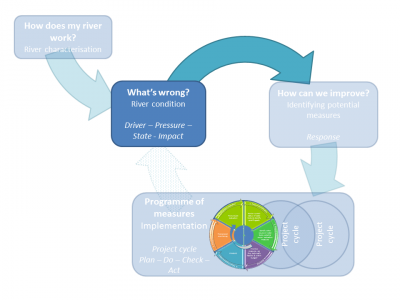Difference between revisions of "River condition"
(→HYMO Assessment methods) |
|||
| (8 intermediate revisions by 2 users not shown) | |||
| Line 1: | Line 1: | ||
== What's wrong? == | == What's wrong? == | ||
| − | [[File:Base_structure_wiki_box_2.PNG|thumb|400px|right|link= | + | [[File:Base_structure_wiki_box_2.PNG|thumb|400px|right|link=What's_in_this_wiki?|What's in this wiki? Click image to return to the overview of river basin management plan.]] |
<br /> | <br /> | ||
| − | The second stage of river basin planning is to assess what is wrong. | + | The second stage of river basin planning is to assess what is wrong. It is advised to review the [[How does my river work?]] section first before continuing reading this section. |
| − | + | ||
| − | + | ||
| − | + | ||
<br /> | <br /> | ||
| − | |||
| − | |||
| − | |||
| − | |||
| − | |||
| − | |||
<br /> | <br /> | ||
| − | = | + | REFORM researched methods for assessing the hydromorphology (HYMO) and biological elements. We follow the selection of elements used in the [http://eur-lex.europa.eu/legal-content/EN/TXT/?uri=CELEX:02000L0060-20090625 Water Framework Directive] for river quality assessment. <br /><br /> |
| + | Once we know how our river works, we can assess what is wrong. This regards both [[HYMOQE|hydromorphological quality]] and [[BQE|biological quality]]. Based on the outcomes of the REFORM project, we recommend using the hydromorphological assessment method for ecological class assessment directly, circumventing the use of biological indicators. Degradation of quality can be due to [[Pressures|hydromorphological pressures]], although it is often difficult to single out the effects of these pressures compared to other pressures in a multi-stressor environment.<br /> | ||
<br /> | <br /> | ||
| − | + | REFORM reviewed existing tools and developed new tools for [[Hydromorphological_assessment_methods|hydromorphological assessment]]. | |
| − | + | <br/> | |
| − | <br /> | + | |
| − | + | ||
| − | + | ||
| − | + | ||
| − | + | ||
| − | + | ||
Latest revision as of 11:33, 3 January 2019
What's wrong?
The second stage of river basin planning is to assess what is wrong. It is advised to review the How does my river work? section first before continuing reading this section.
REFORM researched methods for assessing the hydromorphology (HYMO) and biological elements. We follow the selection of elements used in the Water Framework Directive for river quality assessment.
Once we know how our river works, we can assess what is wrong. This regards both hydromorphological quality and biological quality. Based on the outcomes of the REFORM project, we recommend using the hydromorphological assessment method for ecological class assessment directly, circumventing the use of biological indicators. Degradation of quality can be due to hydromorphological pressures, although it is often difficult to single out the effects of these pressures compared to other pressures in a multi-stressor environment.
REFORM reviewed existing tools and developed new tools for hydromorphological assessment.
